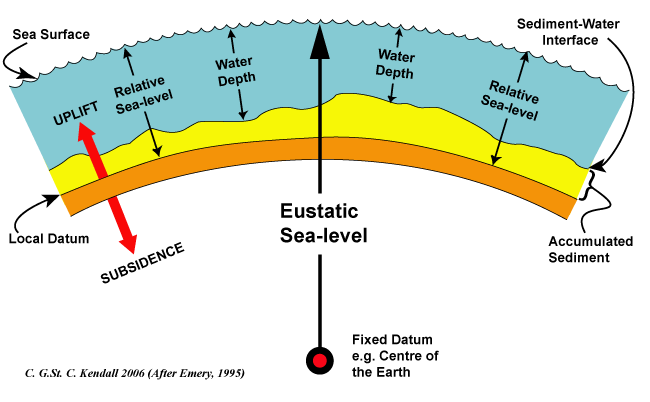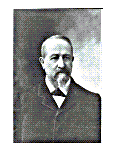|
accommodation
relative sea level

|
The term eustasy refers to global sea level independent of local factors; namely the position of the sea surface with reference to a fixed datum including the center of the earth or a satellite in fixed orbit around the earth.
The word "eustatic" was first used by Eduard Suess in 1888 and was translated by William Johnson Sollas in 1906. Eustasy was first used by Clarence Dutton in 1889 who first spelled this as eustacy but when it was realized that Greek had no “c” the spelling of the word was changed to eustasy. Hallam (1984) drives this etymological point home by pointing out that out ecstasy has no ‘c’ either.

Size of changes in eustatic Levels
It is impossible to determine the size of the variations in eustatic position that occurred during deposition sedimentary section (Guidish et al, 1984; Burton et al, 1987; Kendall and Lerche, 1989). This is because of the position of the sea varies as a function of eustasy, tectonic behavior and sedimentary fill. It can be demonstrated that if the size of two of the variables are specified then third can be established. This presents a problem since the sizes of all three of these variables are unknown. The solution chosen by most earth scientists is to assume a "reasonable" size for two of the three variables and solve for the third.
In contrast the position of the present day sea level can be measured and determined from orbiting satellites.
Schemes that purport to measure the size of Sea Level Variations
Tidal gauges sited along modern coastlines assume general models of tectonic behavior and sediment deposition.
Hypsometric curves compiled for present-day topography of the continents have been the basis for many estimates of the magnitude of excursion is eustasy. They are used as a general baseline from which to measure and overall sea-level rise through the Phanerozoic, and a means for examining the relative magnitudes of sea level.
Sediment aggradation and onlapping geometries from seismic stratigraphy is used and based on the argument that the position of the onlapping seismic reflectors is controlled by the base level of the mean high water mark. The problem is that crustal movement and sediment compaction varies from basin to basin and also exaggerate the size of the eustatic excursions.
Paleobathymetric markers tied ancient strandline positions and/or the sediment thickness of shoaling upward cycles equted with the size of sea level excursions require assumptions either about the tectonic behavior of the depositional setting, and/or eustasy, and/or sedimentation.
Backstripped subsidence to determine the magnitudes of eustasy from the differences between crustal subsidence and thermo-tectonic curves. This scheme assumes an equilibrium isostatic burial history; a model of isostatic and flexural response to sediment and water weight; a model of sediment compaction.
isotope ratios and coral reef terraces assume models of ice volume and tectonic subsidence.
Models that simulate the sediment geometry at basin margins again use assumed general models of tectonic behavior and sediment deposition.
Dramatic Personae
| Eduard Suess (1831-1914) was the outstanding Austrian geologist whose contribution to sequence stratigraphy was his recognition of world wide changes in sea level, or eustasy! He was also among the first to recognize the link between paleogeography and tectonics. |
 |
| William Johnson Sollas Chair of Geology at Trinity College, Dublin (1893-1897). Elected an F.R.S. in 1889. Translated Eduard Suess's book, "The face of the Earth", introducing English speaking geologists to eustatic! |
 |
| Clarence Dutton proselytized Eduard Suess's work while confusing us with eustasy versus eustacy. Better know as the pioneer in seismology who recognized isostasy. |
 |
References
Burton, R., C.G.St.C.Kendall, and I. Lerche, 1987, Out of Our Depth: On the Impossibility of Fathoming eustasy from the Stratigraphic Record, Earth Science Review, v. 24, p. 237- 277
Guidish, T.M., C.G.St.C.Kendall, I. Lerche and J.J. O'Brien, l984, Relationship between eustatic level changes and basement subsidence: Am. Assoc. Petroleum Geol. Bull., v. 68, p. l64- l77.
Hallam, Anthony, 1984, Pre-Quaternary sea-level changes, Ann. Rev. Earth Planet. Sci. . 12 : 205-43
Kendall, Christopher G.St.C., and Ian Lerche, 1988, The Rise and Fall of eustasy, In Wilgus, C.K., Hastings,B.S., Kendall, C.G.St.C., Posamentier H.W., Ross,C.A., and Van Wagoner,J.C., eds., Sea-Level Changes - an Integrated Approach, SEPM Spec. Pub. 42, p 3-17
Suess, E. 1906. The Face of the Earth, (Translated by H. B. C. and W. J. Sollas) Vol. 2, Oxford : Clarendon. 759 pp. |